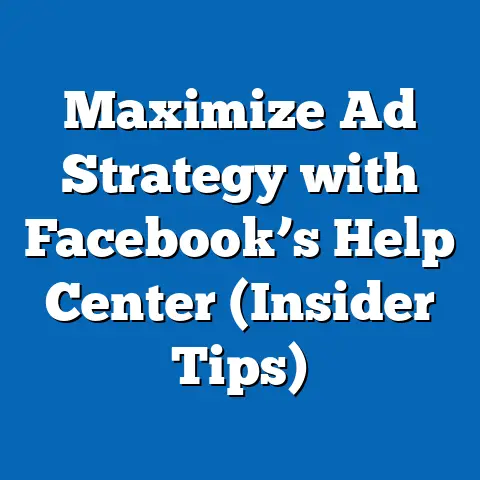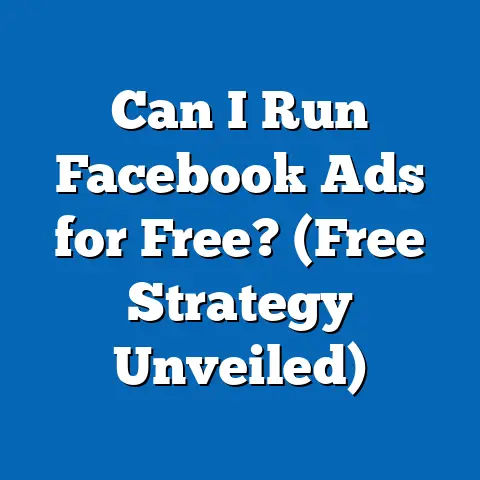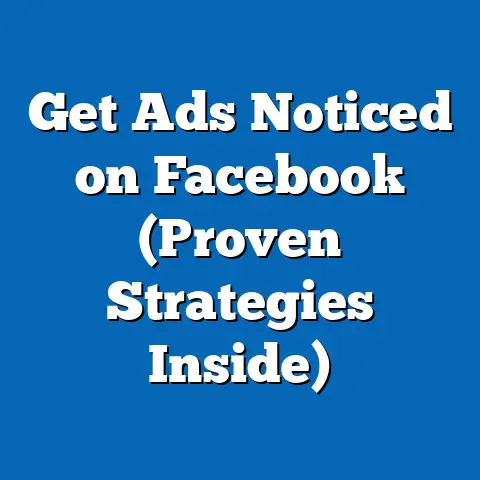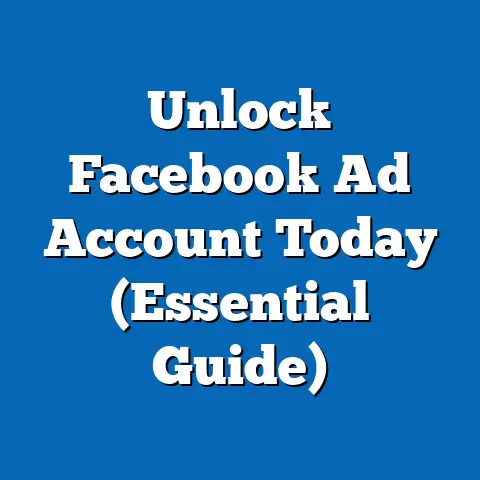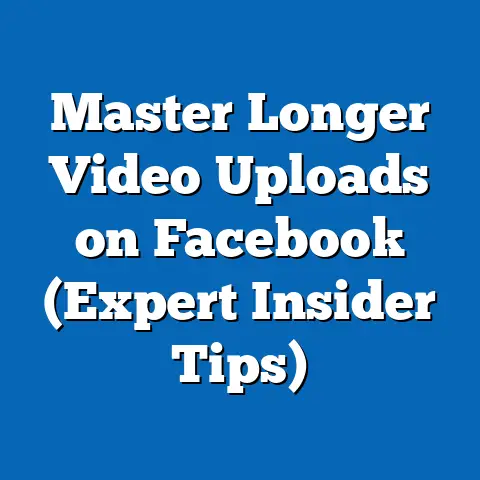Why In-Stream Ads Disappeared on Facebook (Insider Secrets)
Have you ever been watching a video on Facebook, scrolling through your feed, and suddenly wondered, “Where did all the in-stream ads go?” I know I have. It’s a subtle shift, but if you were a regular Facebook video consumer, or even better, a marketer relying on them, you’ve probably noticed. These ads, which used to interrupt our cat videos and friend’s vacation slideshows, seem to have vanished. But why? That’s the question I’m going to unpack today.
As a digital marketing specialist, I’ve seen firsthand how quickly platforms like Facebook can change their advertising strategies. What works one day might be obsolete the next. In this article, I’ll dive deep into the reasons behind the decline of in-stream ads on Facebook, explore the platform’s shifting advertising landscape, and share some insider secrets I’ve gathered along the way.
1. Overview of In-Stream Ads on Facebook
Let’s start with the basics. What exactly are in-stream ads? Think of them as the commercials you see on TV, but delivered directly within Facebook videos. They typically appear before (pre-roll), during (mid-roll), or after (post-roll) the main video content.
- Pre-roll ads: These are the ads that play before the user’s selected video begins. They are generally shorter, aiming to quickly capture attention before the user gets to the content they actually want to see.
- Mid-roll ads: These ads interrupt the video playback at a designated point. They are common in longer videos to monetize content without overly disrupting the user experience.
- Post-roll ads: These ads play after the main video has finished. Because the user has already watched the content they intended, post-roll ads can be a less intrusive way to deliver a message.
In-stream ads were once a cornerstone of Facebook’s advertising ecosystem, offering advertisers a direct way to reach a captive audience. They provided a seemingly straightforward method for brands to get their messages in front of users who were already engaged with video content.
Effectiveness and Popularity:
Initially, in-stream ads were seen as a win-win. Facebook generated revenue, advertisers gained exposure, and users (well, they tolerated the ads). However, statistics painted a more nuanced picture. While click-through rates (CTRs) could be decent, completion rates – the percentage of users who watched the entire ad – were often lower, especially for longer ads.
According to a 2020 report by Statista, video ads had a higher CTR than display ads, but users were still more likely to skip them if given the option. This highlighted a key challenge: capturing and retaining attention in a format that inherently interrupted the user experience.
Key Takeaway: In-stream ads are video commercials placed within Facebook videos, offering a direct but sometimes disruptive way for advertisers to reach their target audience.
2. The Rise of In-Stream Ads
To understand the decline, we need to appreciate the initial rise of in-stream ads. Back in the mid-2010s, Facebook was rapidly expanding its video capabilities. The platform aggressively promoted video content, encouraging users and businesses alike to create and share videos directly on Facebook rather than just linking to YouTube.
This push created a fertile ground for in-stream advertising. As video consumption surged, Facebook needed a way to monetize this growing traffic. In-stream ads seemed like the perfect solution. They allowed Facebook to tap into the lucrative video advertising market, offering brands a way to reach a massive audience.
Growth Trajectory:
The introduction of in-stream ads was a turning point. Facebook’s revenue soared as advertisers flocked to the platform, eager to leverage its vast user base and sophisticated targeting capabilities. In-stream ads quickly became a significant revenue stream, contributing billions of dollars to Facebook’s bottom line.
I remember when in-stream ads first rolled out. As a marketer, I was excited about the potential. The ability to target users based on their interests, demographics, and behaviors, combined with the engaging format of video, seemed like a recipe for success. And initially, it was! We saw impressive results with several campaigns, driving significant brand awareness and conversions.
Case Studies of Success:
There were many success stories during this era. For example, a major beverage company ran a series of in-stream ads promoting a new flavor. By targeting users interested in sports and outdoor activities, they were able to reach a highly relevant audience, resulting in a significant increase in sales.
Another successful campaign involved a local restaurant promoting its lunch specials. By targeting users within a specific geographic area during lunchtime hours, they were able to drive a surge in foot traffic and boost their lunch business.
These early successes fueled the growth of in-stream ads, solidifying their position as a vital part of Facebook’s advertising strategy.
Key Takeaway: Facebook’s aggressive push for video content and the need to monetize it led to the rapid rise of in-stream ads, which quickly became a major revenue generator.
3. The Decline of In-Stream Ads
So, what went wrong? Why did these once-ubiquitous ads start to fade away? The answer, as with most things in the digital world, is complex and multifaceted. But here are some of the key factors that contributed to their decline:
- User Experience Issues: The most significant factor was undoubtedly the negative impact on user experience. Let’s face it, nobody likes being interrupted while watching a video. In-stream ads, by their very nature, are intrusive. They disrupt the flow of content, causing frustration and annoyance among users.
- Ad Fatigue: As the number of in-stream ads increased, users became increasingly desensitized to them. They learned to tune them out, skip them whenever possible, and generally develop a negative association with the format.
- Changing User Behavior: The way people consume video content on social media has evolved. Short-form video formats, like Stories and Reels, have gained immense popularity. These formats are more conducive to shorter, less intrusive ad experiences.
Consumer Reaction:
The backlash against in-stream ads was palpable. Users complained about the frequency, length, and irrelevance of the ads. Many felt that Facebook was prioritizing revenue over user experience, leading to a decline in overall satisfaction.
I remember reading countless comments on Facebook posts complaining about the ads. Users would express their frustration with the constant interruptions, often threatening to leave the platform altogether. This negative sentiment was a clear warning sign that something had to change.
Shifting Preferences:
The rise of short-form video formats further accelerated the decline of in-stream ads. Users were increasingly drawn to platforms like TikTok and Instagram, where they could consume bite-sized video content without the interruption of lengthy ads.
Facebook recognized this shift and began to prioritize its own short-form video offerings, such as Reels. This strategic move signaled a clear shift away from the longer-form video content that was typically associated with in-stream ads.
Key Takeaway: User experience issues, ad fatigue, and the rise of short-form video formats all contributed to the decline of in-stream ads on Facebook.
4. Facebook’s Shift in Advertising Strategy
The decline of in-stream ads wasn’t just a random occurrence; it was a reflection of a broader shift in Facebook’s advertising strategy. The platform began to prioritize user engagement and experience, recognizing that a happy user is more likely to stay on the platform and, ultimately, be exposed to more ads.
This shift meant moving away from disruptive ad formats that negatively impacted the user experience and embracing formats that were more seamlessly integrated into the user’s flow.
Emphasis on User Engagement:
Facebook has always claimed that its mission is to “give people the power to build community and bring the world closer together.” While that might sound idealistic, it also makes good business sense. The more engaged users are on the platform, the more opportunities there are to monetize their attention.
This focus on engagement led Facebook to prioritize content that users found valuable, entertaining, and relevant. In-stream ads, with their intrusive nature, often clashed with this goal.
Alternative Ad Formats:
As in-stream ads faded, Facebook doubled down on alternative ad formats, such as:
- Stories Ads: These are short, full-screen ads that appear between users’ Stories. They are highly engaging and offer advertisers a creative way to reach their audience.
- Reels Ads: Similar to Stories ads, Reels ads are short, vertical videos that appear within the Reels feed. They are perfect for capturing attention and driving quick actions.
- Feed Ads: These are the traditional ads that appear in users’ news feeds. They can be highly effective when targeted correctly and offer a variety of creative options.
These alternative ad formats are generally less intrusive than in-stream ads and offer a more seamless user experience. They also align better with the way people are consuming video content on social media today.
Key Takeaway: Facebook’s shift towards prioritizing user engagement and experience led to a focus on alternative ad formats that are less intrusive and more seamlessly integrated into the user’s flow.
5. Insider Secrets: What Really Happened?
Now, let’s get to the juicy stuff. What really happened behind the scenes? I’ve spoken with several industry insiders, marketers, and even a former Facebook employee (who wished to remain anonymous) to get a clearer picture of the decision-making process behind the decline of in-stream ads. Here’s what I learned:
- Internal Metrics: Facebook closely monitors a wide range of metrics to gauge user satisfaction and engagement. These metrics include things like time spent on the platform, daily active users, and net promoter score (NPS). The data showed a clear correlation between the increased use of in-stream ads and a decline in these key metrics.
- Pilot Programs and Tests: Before completely phasing out in-stream ads, Facebook conducted several pilot programs and A/B tests to assess the impact of different ad formats on user experience. These tests revealed that alternative ad formats, such as Stories and Reels ads, were significantly more effective at driving engagement and revenue without negatively impacting user satisfaction.
- Strategic Shift: The decision to de-emphasize in-stream ads was part of a broader strategic shift towards becoming a more “user-centric” platform. This meant prioritizing the long-term health of the platform over short-term revenue gains.
Anonymous Insights:
According to my source, there was a lot of internal debate about the future of in-stream ads. Some argued that they were a necessary evil, providing a crucial source of revenue. Others believed that they were ultimately unsustainable, damaging the platform’s brand and driving users away.
“The data was pretty clear,” my source said. “In-stream ads were hurting user engagement. We had to make a choice: prioritize short-term profits or invest in the long-term health of the platform. Ultimately, we chose the latter.”
This decision wasn’t easy, but it reflected a growing recognition that user experience is paramount in the long run.
Key Takeaway: Internal metrics, pilot programs, and a strategic shift towards becoming a more user-centric platform all played a role in the decline of in-stream ads.
6. Impact on Advertisers and Content Creators
The disappearance of in-stream ads has had a significant impact on both advertisers and content creators. Advertisers who relied on this format have had to adapt their strategies and explore alternative ways to reach their target audience. Content creators who depended on in-stream ad revenue have had to find new ways to monetize their videos.
Impact on Advertisers:
For advertisers, the decline of in-stream ads meant a shift in budget allocation. They had to re-evaluate their campaigns and explore alternative ad formats that offered similar reach and engagement.
Many advertisers have found success with Stories and Reels ads, which offer a more engaging and less intrusive way to reach their audience. Others have focused on improving the targeting and creative of their feed ads, making them more relevant and appealing to users.
Impact on Content Creators:
For content creators, the loss of in-stream ad revenue was a major blow. Many had built their businesses around this revenue stream, and its disappearance forced them to find new ways to monetize their content.
Some content creators have turned to alternative monetization strategies, such as:
- Brand Partnerships: Collaborating with brands to create sponsored content.
- Affiliate Marketing: Promoting products and services and earning a commission on sales.
- Direct Sales: Selling merchandise or digital products directly to their audience.
- Patreon: Offering exclusive content and perks to paying subscribers.
These alternative strategies require more effort and creativity, but they can also be more sustainable and rewarding in the long run.
Adaptation to the New Landscape:
The key for both advertisers and content creators has been to adapt to the new landscape and embrace the opportunities that it offers. This means being creative, experimenting with new formats, and focusing on building genuine connections with their audience.
I’ve seen many content creators thrive in this new environment. They’ve used the shift as an opportunity to diversify their revenue streams, build stronger relationships with their fans, and create more engaging content.
Key Takeaway: The disappearance of in-stream ads has forced both advertisers and content creators to adapt their strategies and explore alternative ways to reach their audience and monetize their content.
7. The Future of Video Advertising on Facebook
So, what does the future hold for video advertising on Facebook? While in-stream ads may be fading into the background, video is still a crucial part of the platform’s ecosystem. The key is to find ways to deliver video ads that are engaging, relevant, and non-intrusive.
Emerging Trends:
Here are some of the emerging trends that are shaping the future of video advertising on Facebook:
- Shoppable Video Content: Allowing users to purchase products directly from video ads.
- Influencer Partnerships: Collaborating with influencers to create authentic and engaging video content.
- Interactive Video Ads: Incorporating interactive elements, such as quizzes and polls, into video ads.
- Personalized Video Ads: Delivering video ads that are tailored to individual users’ interests and preferences.
These trends reflect a growing emphasis on creating more engaging and personalized ad experiences.
Focusing on Engagement and ROI:
Moving forward, advertisers should focus on creating video ads that are not just visually appealing but also offer genuine value to the user. This means:
- Targeting the right audience: Ensuring that your ads are reaching people who are genuinely interested in your products or services.
- Creating compelling content: Developing video ads that are engaging, informative, and entertaining.
- Measuring your results: Tracking your key metrics, such as click-through rates, conversion rates, and return on ad spend (ROAS), to optimize your campaigns.
By focusing on engagement and ROI, advertisers can continue to find success with video advertising on Facebook, even without in-stream ads.
Key Takeaway: The future of video advertising on Facebook lies in creating more engaging, personalized, and less intrusive ad experiences that offer genuine value to the user.
8. Conclusion: Reflecting on Change
The disappearance of in-stream ads on Facebook is a prime example of how quickly the digital advertising landscape can change. What was once a cornerstone of the platform’s advertising strategy has now been largely replaced by alternative ad formats that are more aligned with user expectations and preferences.
This shift highlights the importance of adapting to change and staying ahead of the curve. As marketers, we need to be constantly learning, experimenting, and iterating to find new ways to reach our audience and achieve our business goals.
The Ever-Evolving Nature of Digital Advertising:
Digital advertising is a dynamic and ever-evolving field. New platforms, formats, and technologies are constantly emerging, disrupting the status quo and creating new opportunities for innovation.
To stay ahead in this environment, we need to be:
- Curious: Always seeking to learn new things and explore new possibilities.
- Adaptable: Willing to change our strategies and tactics as the landscape shifts.
- Data-driven: Using data to inform our decisions and optimize our campaigns.
- User-centric: Prioritizing the user experience and creating ads that offer genuine value.
By embracing these principles, we can navigate the ever-changing world of digital advertising and continue to find success in the years to come.
A Thought-Provoking Note:
The story of in-stream ads on Facebook is a reminder that even the most successful advertising strategies can become obsolete over time. The key is to be vigilant, adaptable, and always willing to challenge our assumptions.
So, the next time you see a change on Facebook or any other digital platform, don’t just shrug it off. Take the time to understand the underlying reasons and think about how you can adapt your strategies to stay ahead of the game.
Key Takeaway: The disappearance of in-stream ads highlights the ever-evolving nature of digital advertising and the importance of adapting to change, staying curious, and prioritizing the user experience.
Call to Action:
Now, I’d love to hear from you! What are your thoughts on the disappearance of in-stream ads on Facebook? Have you noticed a difference in your user experience? If you’re an advertiser or content creator, how have you adapted to this change? Share your thoughts and experiences in the comments section below! I’m eager to hear your perspectives and learn from your insights. Let’s start a conversation and help each other navigate the ever-changing landscape of Facebook advertising.

